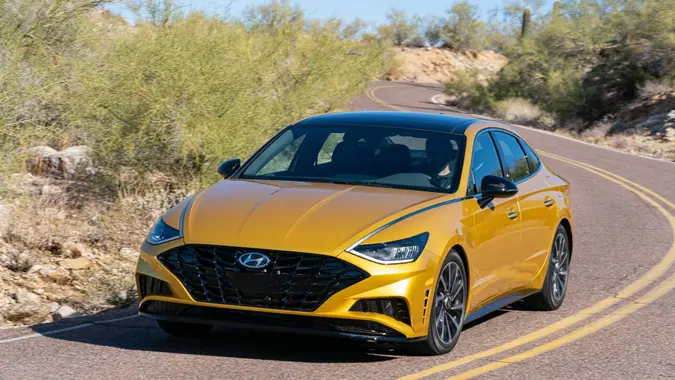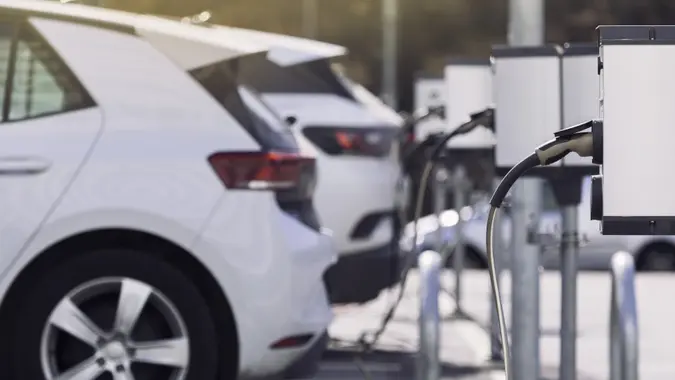How To Save for a Car: Step-by-Step Guide for Any Budget

Commitment to Our Readers
GOBankingRates' editorial team is committed to bringing you unbiased reviews and information. We use data-driven methodologies to evaluate financial products and services - our reviews and ratings are not influenced by advertisers. You can read more about our editorial guidelines and our products and services review methodology.

20 Years
Helping You Live Richer

Reviewed
by Experts

Trusted by
Millions of Readers
With the average monthly payment for a new car now $737, according to Experian, it’s more important than ever to plan ahead. This guide explains how to save for a car on any budget — whether you’re aiming for a down payment or the full purchase price.
Key Takeaways
- Before you start saving, figure out how much car you can realistically afford.
- Setting aside savings each month for a car can help you build a solid down payment or even buy a car outright.
- A 20% down payment is recommended for new cars — 10% may be enough for a used one.
How To Save for a Car: Step by Step
Saving for a car isn’t just about putting money aside — it starts with understanding what you can realistically afford. From setting a budget to building a solid down payment, here are the key steps to take before you buy.
1. Set a Realistic Budget
Take a look at your budget to determine how much you can afford to spend on a vehicle each month. Be sure to include hidden costs, like insurance, gas and maintenance.
For example, if you have $500 a month to spend on a car, make sure that includes all your related expenses — not just the loan payment.
If you want to skip a monthly payment entirely, buying a vehicle in cash could be an option — but it’s not realistic for everyone.
2. Calculate Your Down Payment
Once you know your target monthly car payment, use online calculators to see how much you need to put down to reach it. You can bring your payment down by choosing a longer loan term or increasing your down payment.
Don’t forget to factor in your trade-in as part of the down payment, if you’ll have one.
Pro Tip
Try to avoid car loans longer than five years. A three- to four-year term usually means less interest overall.
If the monthly payment is still too high, either increase your savings goal or consider a more affordable vehicle. For example, you might choose a small sedan that gets the job done instead of a full-sized SUV in order to save significantly.
3. Set Up a Dedicated Car Savings Account
A smart way to save your car down payment is to start making that monthly car payment to yourself. Put it into a dedicated savings account, ideally one with low fees and a high annual percentage yield. It will be part of your budget soon enough anyway.
4. Automate Your Savings
If you can’t easily save that monthly payment, you’ll have difficulty keeping up with monthly loan payments. Automating your savings can help.
If you receive paychecks via direct deposit, elect to send some of it to your savings account. Or set up automatic transfers from another bank account into your dedicated car savings each month.
5. Pick Up a Side Hustle To Save Faster
It can take several months to save up a down payment. Find ways to cut out some non-essential monthly expenses or pick up a side gig to reach your goal faster.
Good To Know
Wondering how to save for a used car? Start with a smaller savings goal. Used cars typically cost less than new ones, which means lower down payments and often lower monthly costs. Prioritize setting aside enough for repairs or inspections and focus on models known for reliability.
How To Save Money for a Car With Low Income
If you are saving for a car on a low income, the first thing to do is set realistic expectations. A brand-new vehicle might not be feasible, but a safe, used car would be within reach.
Start by trimming unnecessary expenses, such as eating out or subscription services. If your budget is already tight, increasing your income may be your best bet. Picking up extra hours or building a side hustle could help you reach your savings goals faster.
Additional Costs To Plan For
With a vehicle, the monthly cost will be more than just the car payment. You’ll also need to consider auto insurance, gas, maintenance and repair costs.
If you currently have a car and a car payment, you already have a good idea of your monthly car spend. However, if you are buying your first car, you’ll need to do some homework. Find an online calculator that provides yearly ownership estimates for different car makes and models.
Suppose you determine the following monthly costs for a two-year-old sedan:
- Maintenance: $60
- Repairs: $8
- Fuel: $100
- Insurance: $60
- Total: $228
If you can afford to spend $650 per month on a car, you’ll have $422 after expenses for a monthly car payment.
Final Takeaway
Knowing how to save for a car is only part of getting into a vehicle that fits your budget. You also want to get the best deal on the vehicle and the financing.
While saving for that down payment, do anything necessary to improve your credit score to ensure the best financing rate. Also, start researching how to negotiate the best deal when buying a car, especially if you’ll be going to a dealership.
Saving for a Car: FAQ
Still have questions about how to save for a car? These common questions can help clarify everything from budgeting tips to how much you really need to save.- What's the best way to save money for a car?
- Some of the best ways to save money for a car include setting up a dedicated savings account, automating your savings goal and picking up a side hustle to accelerate your progress.
- How do I save for a car in three months?
- If you want to save for a car in just a few months, you'll likely need to make significant cuts to your spending and/or pick up a side hustle. As you create more financial space, funnel that money toward your car savings goal.
- What are good ways to save for a car with a low income?
- When saving for a car on a low income, cutting back on discretionary purchases is a good place to start. If you don't have room to make spending cuts, picking up extra income through more work or a side hustle could help you meet your savings goals.
- How much money do I need to save for a car?
- The amount you'll need to save for a vehicle varies based on your situation. Generally, you'll want to save up at least a 20% down payment for a new car or 10% down for a used car.
- What is the 20% rule when buying a car?
- Generally, you'll want to make a down payment of at least 20% on a new car purchase.
- How can you save money for a car quickly?
- If you want to save money for a car fast, start by cutting back on any discretionary spending. Beyond that, picking up a side hustle, like dog walking or freelance writing, could help you make faster progress toward your goal.
Andrea Norris contributed to the reporting for this article.
Our in-house research team and on-site financial experts work together to create content that’s accurate, impartial, and up to date. We fact-check every single statistic, quote and fact using trusted primary resources to make sure the information we provide is correct. You can learn more about GOBankingRates’ processes and standards in our editorial policy.
- Cox Automotive. 2022. "New-Vehicle Affordability Declines Again in May, Typical Monthly Payment Hits New Record of $712."
- Edmunds. "Cost of Car Ownership."
- Experian. 2024. "Average Car Payment in 2024."
 Written by
Written by  Edited by
Edited by 

























